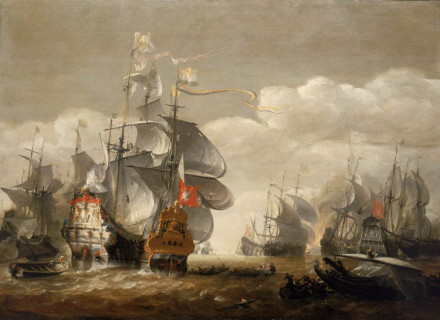History
She was one of the largest VOC ships of the time, and made nine successful voyages to the Dutch holdings in Asia for trading purposes. In 1665, during the Second Anglo-Dutch War, Oranje was hired by the Zeeland Admiralty to serve as a warship. This was a common practice at the time, as the Dutch navy had only a small number of purpose-built warships, and would augment their fleet with converted merchantmen.
Battle of Lowestoft
Under command of Bastiaan Senten, Oranje was sent to what would become the Battle of Lowestoft on 13 June, 1665. After a damaging English blockade at the start of the Second Anglo-Dutch War, the Dutch were anxious to prevent a second, and the Dutch Lieutenant-Admiral Jacob van Wassenaer Obdam, in command of a Dutch fleet of 103 ships, was order to attack the English fleet of 109 ships near the English coast town of Lowestoft. Van Wassenaer was instructed to attack the English fleet aggressively while the Dutch fleet held the weather gage, meaning that the Dutch fleet was upwind of the English ships. This position is a strong position for attack in naval battles. For unknown reasons, however, van Wassenaer postponed the battle until the wind had shifted, and the Dutch fleet held the more defensible leeward position.

While both fleets were made up of almost the same number of ships, the Dutch fleet was more vulnerable in terms of ship construction,ship size, and firepower. Dutch ships were on average much smaller and more lightly constructed than English vessels, and carried a much lighter firing weight, as the largest guns carried by the Dutch were on average 24 pounders, while English vessels commonly carried 42 pounders. The English fleet was also made up of more purpose-built warships, while the Dutch fleet contained a greater number of converted merchantmen. The English fleet was also much more organized, and it is possible that van Wassenaer felt that his fleet was inferior to the English fleet to strongly attack with the weather gage, and so chose to wait to attack until the Dutch fleet held the leeward position, which would make it possible for the fleet to retreat if needed.
After a series of passes, the Dutch fleet failed to maintain a line of battle, and the fleet descended into chaos. There are differing accounts of the remainder of the battle, as the actual manoeuvres of both fleets remain disputed. At this point, however, the Dutch flagship Eendracht was duelling the English first rate ship-of-the-line Royal Charles, when Eendracht exploded, killing most of her crew as well as Lieutenant-Admiral van Wassenaer. As the Dutch second in command was also fatally wounded at this time, the Dutch fleet was left without effective command. Dutch ships began to flee from the battle one by one, and Oranje, which had been set on fire by a fireship, attempted to block any pursuers of the Dutch fleet. Oranje kept burning, and eventually sank.
The Battle of Lowestoft was a clear English victory, as the English lost only one ship, and had between 300-500 casualties, while the Dutch fleet lost 17 ships, with many more captured by the English, and between 2000-2500 were killed, while around a further 2000 were captured.
Description
Type: Dutch East Indiaman
Built: VOC Wharf: Middelburg, 1643
Owner: VOC Chamber: Zeeland
Dimensions: 170 x 38 x 14 ft
Tonnage: 1200 (carrying capacity including orlop deck; without orlop deck: 700 tons)
Complement: 176
Master: on final merchant voyage: Reinier Reiniersz.
Captain: during Battle of Lowestoft: Bastiaan Senten

| Skipper | Centen, Sebastiaen |
|---|---|
| People on board | 450 |